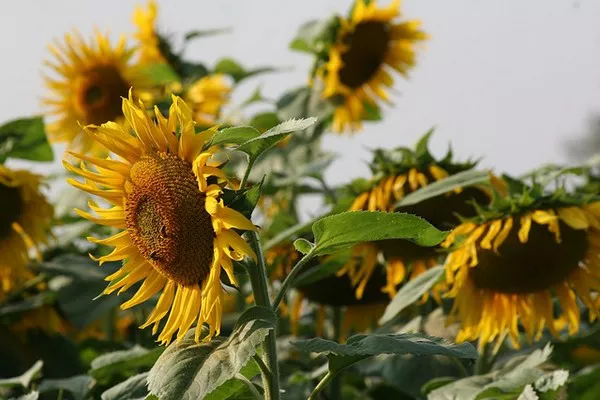Sunflowers, with their radiant blooms and towering stalks, are not only iconic symbols of summer but also represent a diverse array of cultivars, each with its own unique characteristics and uses. From the classic bright yellow petals to exotic multi-colored hybrids, the world of sunflowers offers a stunning spectrum of options for gardeners, farmers, and flower enthusiasts alike. In this comprehensive article, we delve into the fascinating world of sunflower varieties, exploring their origins, features, and the myriad ways in which they enrich our lives.
The Sunflower’s Botanical Splendor
Before we embark on our journey to discover the multitude of sunflower types, it’s essential to understand the botanical basics of these majestic plants. Sunflowers belong to the genus Helianthus, which is derived from the Greek words “helios” meaning sun and “anthos” meaning flower. True to their name, sunflowers exhibit a phenomenon called heliotropism, where young blossoms track the sun’s movement across the sky, a behavior that ceases once the flower reaches maturity.
The Classic Sunflower: Helianthus annuus
When most people envision a sunflower, they likely picture the quintessential Helianthus annuus, or common sunflower. This iconic species is native to North America and boasts large, golden-yellow blooms with dark brown centers, known as discs. Helianthus annuus is not only a favorite among gardeners for its vibrant appearance but also holds agricultural significance as a source of edible seeds and oil.
Beyond the Basics: Exploring Varieties
While Helianthus annuus reigns supreme in the world of sunflowers, there exists a vast array of cultivars and hybrids, each offering its own distinct allure. Let’s delve deeper into some of the most notable varieties:
1. Dwarf Sunflowers: Petite Beauties
Ideal for small gardens or container planting, dwarf sunflowers (Helianthus annuus) exhibit all the splendor of their larger counterparts but on a more compact scale. These diminutive varieties typically reach heights of 1 to 2 feet, making them perfect for borders, edging, or decorative pots. Popular cultivars include ‘Music Box’ and ‘Teddy Bear,’ which produce cheerful blooms in shades of yellow and gold.
2. Giant Sunflowers: Towering Marvels
On the opposite end of the spectrum are giant sunflowers, known for their staggering heights and colossal blooms. While many cultivars fall under this category, one of the most renowned is the ‘Russian Mammoth’ (Helianthus annuus), which can soar to heights of 12 feet or more, with flower heads measuring over a foot in diameter. These towering marvels make a dramatic statement in gardens and are a favorite among competitive growers seeking to break records.
3. Ornamental Sunflowers: A Riot of Color
Beyond the traditional yellow hues, ornamental sunflowers encompass a kaleidoscope of colors, patterns, and petal shapes, adding visual interest and diversity to any landscape. Varieties such as ‘Moulin Rouge’ and ‘Ring of Fire’ showcase striking bi-colored blooms, while ‘Strawberry Blonde’ captivates with its delicate blend of peach, pink, and cream. With their artistic flair, ornamental sunflowers are prized for bouquets, floral arrangements, and as focal points in garden design.
4. Pollenless Sunflowers: A Blessing for Allergy Sufferers
For individuals sensitive to pollen, pollenless sunflowers offer a welcome solution without sacrificing beauty or charm. These specially bred cultivars produce flowers devoid of pollen, making them an ideal choice for allergy sufferers or those seeking low-maintenance blooms. Varieties such as ‘Sunrich’ and ‘Sunfinity’ boast abundant, pollen-free flowers that retain all the appeal of traditional sunflowers without the risk of triggering allergic reactions.
5. Perennial Sunflowers: Enduring Elegance
While most sunflowers are annuals, meaning they complete their life cycle within a single growing season, there are perennial varieties that return year after year, bringing enduring beauty to the garden. Perennial sunflowers, such as Helianthus maximiliani and Helianthus salicifolius, form clumps of sturdy stems adorned with bright yellow blooms, providing a reliable source of late-season color and nectar for pollinators.
Cultivating Sunflowers: Tips for Success
Whether you’re a seasoned gardener or a novice enthusiast, growing sunflowers can be a rewarding experience with the right knowledge and techniques. Here are some essential tips for cultivating sunflowers:
Site Selection: Choose a sunny location with well-drained soil for optimal growth and flowering.
Planting: Sow sunflower seeds directly into the ground after the danger of frost has passed, spacing them according to the specific requirements of the chosen variety.
Watering: Sunflowers have deep root systems and prefer deep, infrequent watering rather than frequent shallow watering. Avoid overhead irrigation to prevent fungal diseases.
Fertilization: Incorporate a balanced fertilizer into the soil before planting, and side-dress with additional fertilizer as needed throughout the growing season.
Support: Taller varieties may require staking or support to prevent them from toppling over in strong winds. Use bamboo stakes or a trellis for added stability.
Pest and Disease Management: Monitor plants regularly for signs of pests or diseases, and take appropriate action to prevent damage. Organic pest control methods, such as companion planting and beneficial insect habitat creation, can help minimize problems.
By following these guidelines and selecting the appropriate varieties for your climate and growing conditions, you can enjoy a bountiful harvest of sunflowers and revel in their radiant beauty throughout the season.
Conclusion
In conclusion, the world of sunflowers is as diverse and captivating as the blooms themselves. From the towering giants to the diminutive dwarfs, from classic yellows to exotic hues, sunflowers offer an endless array of possibilities for gardeners, farmers, and floral enthusiasts alike. Whether adorning gardens, brightening bouquets, or nourishing wildlife, these magnificent plants continue to captivate our hearts and imaginations with their botanical splendor. So, the next time you gaze upon a field of sunflowers or admire a vase of freshly cut blooms, take a moment to appreciate the rich tapestry of diversity that lies within each radiant petal.


